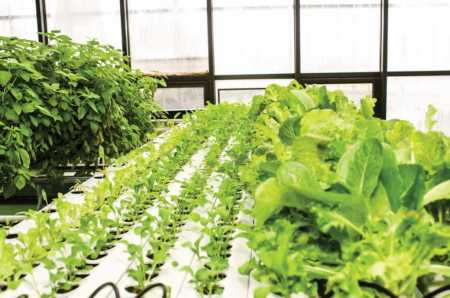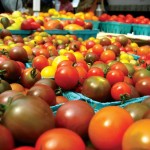Keeping Your Greenhouse Vegetables And Fruits Safe: Focus On Soilless And Hydroponics Systems

Since packaging directly contacts food, packaging materials must meet certain criteria to be considered safe. Image courtesy of Jeremy Keith/Flickr.
The Center for Disease Control and Prevention has found that 46 percent of reported foodborne illnesses are linked to fresh produce and nuts. Although outbreaks associated with greenhouse-grown produce are rare, it is critical that growers follow good agriculture practices (GAP) and good manufacturing practices (GMP) to ensure the food safety risk levels are low.
GAPs are focused on four key areas: water, substrate and biological solids, facilities and people. Food safety behavioral and policy changes in these areas reduce the likelihood of a foodborne outbreak from occurring. GMPs focus on postharvest handling practices including supplies, facilities, equipment and utensils, people and sanitation. This article will focus on two of the four key areas of GAP — water and substrate and biological solids — along with GMP principles associated with packaging.
Our goal for this article is that you will be able to: 1) identify food safety concerns within your facilities related to water management, soil and biological solids and packaging; 2) have a greater knowledge of the food safety resources available; and 3) have an understanding of preventative measurements that can be taken today to reduce your food safety risk.
Know Your Water Source And Test Regularly
Water is an essential component in greenhouse crop production. There have been many foodborne outbreaks associated with water contaminated with E. coli O157:H7, Salmonella and Cyclospora. Within greenhouse production, water is circulated throughout production systems and over the roots, and can contact edible plant parts. Water is also used by employees to wash hands and sanitize equipment and tools. If the water source has biological, physical or chemical contaminants, then the entire system and employees could be at risk.
Water sources can be categorized as low risk or high risk. Municipal water sources are the lowest-risk water sources as they are tested daily by water departments to ensure they are potable. Surface water sources such as ponds or streams are seen as high-risk water sources since the food safety threat depends on the watershed activity and the season.
Unlike municipal water, surface water sources are not tested by a government body and are the responsibilities of the end user. Well water can pose a low or high risk, depending on the well condition and the testing that is completed by the end user.
Surrounding environmental elements can also impact the water quality entering facilities. Some considerations include large trees with root systems that can destroy plumbing, surrounding chemical dumps or landfills that can leach into water and run-off from livestock facilities and/or abundance of wildlife that can contaminate surface water sources and/or leach into the water supply.
It is important for growers to identify their water source and determine associated food safety risks. Growers with municipal water sources should obtain monthly reports from their city or county to ensure water purity, whereas ground and surface water sources require more frequent testing.

It is important for growers to identify their water source and determine associated food safety risks.
Water quality changes with the weather, season and environment. For example, after heavy rains and floods, water quality decreases for surface water sources due to environmental run-off. Well water should be tested four times during the growing season and surface water sources should be tested monthly to ensure safety. Testing frequency can be reduced once growers have data to support the safety of the water supply throughout the year. Contact your local Extension office or university to find the closest water testing laboratory.
Maintain Safe Storage Practices For Substrates And Biological Solids
The elimination of soil in greenhouses does not mean eliminating a food safety risk. In greenhouses, soil is replaced with soilless substrates (growing media), netted pots and production systems, all of which can pose a food safety risk. Common substrates include coir, peat, perlite, rockwool and phenolic foam cubes, which, like soil, can hold harmful chemicals and harbor bacteria along with physical hazards. If these substrates contain harmful contaminants, these can be spread to the crops.
Utilizing a substrate and pots from a reliable supplier that follows both GMP and Hazard Analysis Critical Control Point (HACCP) will help ensure you have a solid food safety program and are monitoring for chemical, biological, and physical hazards. Fertilizers and other nutrient sources should be purchased from reliable sources for purity of product. Employees should follow the instructions supplied by the manufacturers, so the appropriate amount of the chemical or nutrient is applied. Inappropriate application of these substances can result in a chemical or biological hazard being created. In part four of this series, we will discuss in detail sanitation practices for your production systems, facilities, equipment and tools to prevent cross-contamination.
Food safety risk prevention does not stop with reliable suppliers. It is crucial that good handling practices (GHP) are maintained during storage in your facilities. During storage of growing supplies (substrates, pots, fertilizers and nutrients), the temperature, humidity and sunlight can affect the quality and/or safety of these supplies. Additionally, storage conditions should inhibit contamination over time. Storage of supplies on the floors, unclean work tables and the presence of birds can increase the risk of cross-contamination. All chemicals should be stored in a secure location, away from the growth tanks, as spills of chemicals can result in a toxic environment for workers and the plants.
Use High-Quality Food-Grade Packaging And Store Properly
You’ve worked hard to grow the best quality fruits and vegetables for your market, so do not increase your food safety risk after harvesting by selecting poor packaging materials. The U.S. Food and Drug Administration (FDA) has strict requirements for packaging material that is considered food-grade. Since packaging directly contacts food, the FDA considers it a food-contact substance; therefore, packaging materials must abide by certain regulations to be considered safe. Food-grade packaging must be devoid of toxic chemicals and serve as an effective barrier for air and moisture to prevent premature food spoilage. Food-grade packaging materials must be tested to establish that packaging is not hazardous for both humans and animals in accordance to specific toxicological, environmental and chemical indicators. When the FDA determines a material presents no discernible health hazards, it achieves approval as a food-grade material.
The use of non-food-grade packaging may increase your final products’ risk for toxicological, environmental and chemical concerns. Additionally, the reuse of packaging material that is not designed to be re-used will increase your food safety risk. A recent study by the University of Arkansas found that even designed reuse produce bins can harbor foodborne bacteria after proper sanitation. In this study, researchers found that any damage to reuseable plastic bins can provide harborage sites for harmful bacteria to survive and grow. Inspecting these materials is critical if reuse is the best option for your company.
It is easiest to buy packaging materials in bulk and use as needed, but if proper storage does not occur after initial opening, contamination can occur over time. Storing unused packaging material in a way that contamination cannot occur is the best method to reduce food safety risk. For instance, dust can buildup over time on boxes, a leak in the roof or condensation from an air conditioner unit can drip onto the opened packaging materials or a bird’s presence can result in fecal droppings on packaging.
Take Action Toward A Positive Food Safety Culture
Small changes within your facilities can reduce food safety risks to your customers. Your assignment is to focus on on cross-contamination. The first task is to validate that your water source is potable, which may require water testing or obtaining a city water report. The second task is to walk throughout your facility and determine if your supporting material (i. e., substrate, pots, fertilizers, etc. ) are stored appropriately to prevent cross-contamination. Finally, determine if your packaging material is appropriate for produce and is covered during storage to prevent contamination. Also, determine if your transportation vehicle is appropriate for produce transport.
Three Assignments For Growers To Begin Reducing Food Safety Risk
- Confirm that your water source is potable – If you are on a municipal water supply, collect the latest city water report. If you use well water, surface water or other water sources, gather your latest water testing report. Establish a filing system for water testing records.
- Verify that your supporting material is stored in a manner that minimizes cross contamination – Are your substrate, pots, tools and equipment stored in a place where they are not exposed to potential food safety hazards?
- Validate that your packing material is safe – Is your packaging food-grade material or cleanable? Is your produce packed in a manner that no cross contamination can occur?










